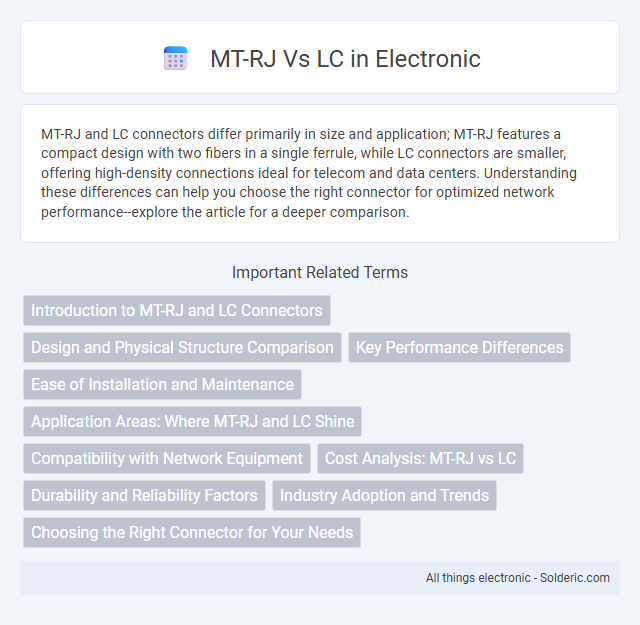MT-RJ and LC connectors differ primarily in size and application; MT-RJ features a compact design with two fibers in a single ferrule, while LC connectors are smaller, offering high-density connections ideal for telecom and data centers. Understanding these differences can help you choose the right connector for optimized network performance--explore the article for a deeper comparison.
Comparison Table
| Feature | MT-RJ | LC |
|---|---|---|
| Connector Type | Mechanical Transfer Registered Jack (MT-RJ) | Lucent Connector (LC) |
| Fiber Type | Single-mode or Multimode | Single-mode or Multimode |
| Connector Size | Compact, dual-fiber in single ferrule | Small form-factor, single-fiber connector |
| Ferrule Diameter | 1.25 mm | 1.25 mm |
| Insertion Loss | Typically 0.5 dB | Typically 0.1 - 0.3 dB |
| Durability | Good, but less popular | High durability, widely adopted |
| Application | Data centers, LANs needing duplex fiber | Telecom, data centers, high-density panels |
| Advantages | Dual-fiber in one connector, space-saving | Lower insertion loss, robust locking, high density |
Introduction to MT-RJ and LC Connectors
MT-RJ and LC connectors are widely used in fiber optic networks for their compact design and efficient performance. MT-RJ connectors combine two fibers in a single rectangular ferrule, optimizing space and enabling quick deployment in high-density environments. LC connectors use a smaller form factor with a latch mechanism, offering low insertion loss and high precision, making them ideal for your high-speed data and telecommunications applications.
Design and Physical Structure Comparison
MT-RJ connectors feature a compact design with two fibers integrated into a single rectangular housing measuring approximately 9x7mm, allowing for high-density installations in limited spaces. LC connectors, smaller at roughly 10x5mm rectangular size with a latch mechanism, utilize a single fiber per connector but offer similar high-density performance through their compact footprint. The MT-RJ uses a push-pull tab for easy insertion and removal, while LC connectors rely on a latch, impacting handling and durability in high-density patch panels.
Key Performance Differences
MT-RJ connectors offer a duplex configuration with a compact size suitable for high-density installations, supporting multimode fiber with insertion loss typically around 0.75 dB. LC connectors provide superior performance in single-mode fiber applications, boasting lower insertion loss of approximately 0.3 dB and higher return loss, which enhances signal integrity over longer distances. Your choice between MT-RJ and LC should consider the specific fiber type and network requirements to optimize overall system performance.
Ease of Installation and Maintenance
MT-RJ connectors, featuring a compact duplex design with two fibers in a single housing, enable quicker and simpler installation compared to LC connectors, which require handling individual duplex connectors. The MT-RJ's standardized push-pull mechanism reduces insertion force and minimizes alignment issues, streamlining maintenance tasks in high-density environments. LC connectors, while widely used, demand more care during installation and cleaning due to their small form factor, potentially increasing maintenance time and complexity.
Application Areas: Where MT-RJ and LC Shine
MT-RJ connectors excel in high-density telecommunications environments, making them ideal for data centers and enterprise networks requiring space-saving fiber optic connections. LC connectors dominate in Fibre Channel storage networks and high-speed data transmissions due to their low insertion loss and robust performance. Both MT-RJ and LC are widely applied in Gigabit Ethernet, but LC's versatility extends to metro networks and long-haul applications.
Compatibility with Network Equipment
MT-RJ connectors offer compact size and are ideal for high-density applications, but their compatibility with network equipment is more limited compared to LC connectors, which are widely supported across various devices and fiber optic systems. LC connectors provide excellent compatibility and are favored for their standardized form factor, ensuring seamless integration with most modern switches, routers, and transceivers. When selecting connectors for your network infrastructure, choosing LC connectors often maximizes equipment interoperability and future-proofing.
Cost Analysis: MT-RJ vs LC
MT-RJ connectors generally cost less per unit compared to LC connectors, making them a budget-friendly choice for small-scale or legacy networks. LC connectors, while slightly more expensive, offer higher performance and durability, which can reduce maintenance costs over time in high-density installations. Your decision should weigh the initial cost savings of MT-RJ against the long-term investment benefits and reliability of LC connectors.
Durability and Reliability Factors
MT-RJ connectors offer enhanced durability with a robust design that reduces damage during frequent handling, making them suitable for high-traffic environments. LC connectors provide superior reliability by maintaining precise fiber alignment through a latch mechanism, minimizing signal loss and ensuring stable connectivity. Your choice between MT-RJ and LC should consider these durability and reliability factors based on the specific demands of your network infrastructure.
Industry Adoption and Trends
MT-RJ connectors have seen limited adoption in industry compared to LC connectors, which dominate due to their smaller size and easier handling. Major telecom and data center providers prefer LC connectors for high-density applications, driving trends toward miniaturization and improved performance. Your network infrastructure benefits from LC's widespread compatibility and growing support in next-generation fiber optic technologies.
Choosing the Right Connector for Your Needs
MT-RJ and LC connectors serve different fiber optic applications with distinct advantages. MT-RJ features a compact design with a duplex form factor ideal for high-density installations, while LC connectors offer lower insertion loss and greater durability, making them suitable for long-haul or high-performance networks. Your choice between MT-RJ and LC should consider factors such as space constraints, network performance requirements, and future scalability.
MT-RJ vs LC Infographic

 solderic.com
solderic.com